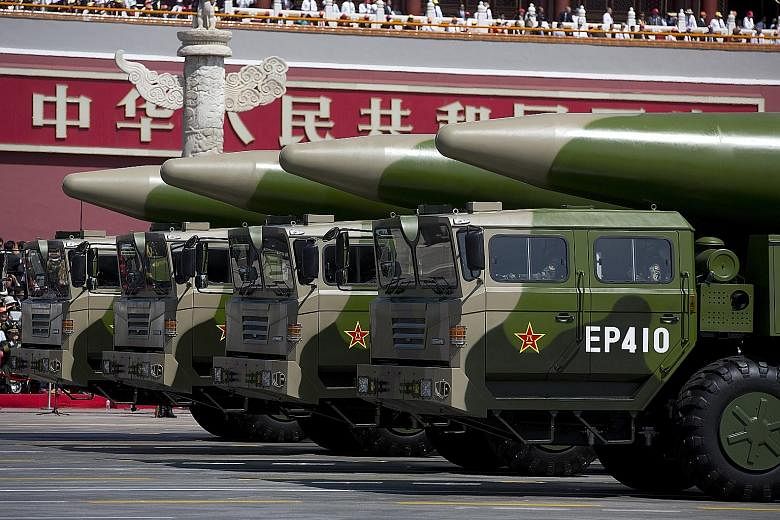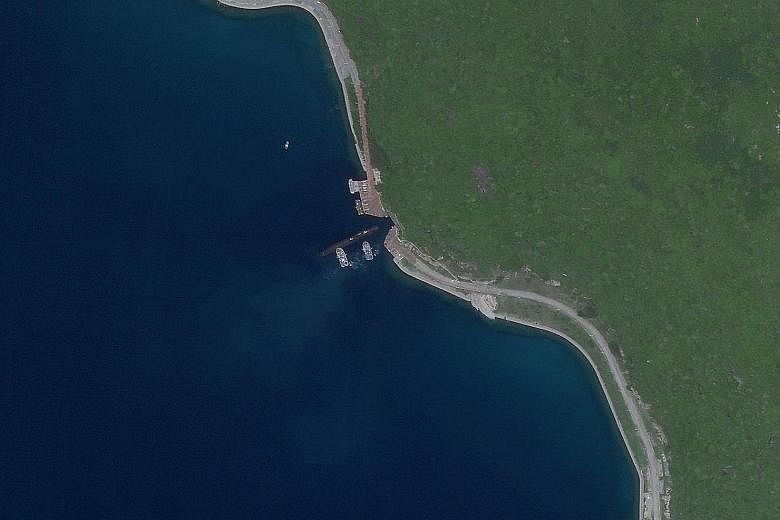In a muscular warning to the United States, China fired a series of missiles into the South China Sea earlier this week, just as the Trump administration sanctioned dozens of Chinese companies linked to China's militarisation of the disputed waters.
Four medium-range ballistic missiles were apparently dropped into waters between Hainan island and the disputed Paracel Islands on Wednesday, as part of the Chinese military's ongoing drills, said media reports, citing sources.
The missile tests come at a time when Sino-US tensions are at their highest in decades, and on the back of heightened military exercises by the People's Liberation Army (PLA) that analysts say are unprecedented.
They also coincide with this year's Rim of the Pacific Exercise, the largest international maritime exercise led by the US, involving 10 navies including Singapore's.
In the latest salvo by the US, its Commerce Department on Wednesday placed visa and trade restrictions on 24 companies for helping the Chinese authorities reclaim and militarise outposts in the contested sea.
China's National Defence Ministry yesterday did not confirm reports of the missile launches, but said it was conducting both sea and air exercises around the Paracel and Spratly islands as part of its annual training schedule.
Its spokesman, Senior Colonel Wu Qian, told reporters at a regular briefing that its recent drills in the South China Sea and the Yellow Sea "are not targeted at any country".
The anti-ship ballistic missiles - with a range of between 1,800km and 4,000km - were launched a day after Beijing expressed anger over an apparent incursion by a US spy plane, which it said had entered a no-fly zone.
The Chinese Defence Ministry called the move by the US a "naked provocative action", saying it had "seriously disrupted China's normal exercises and training activities, seriously violating the China-US maritime and air safety code of conduct and related international practices, and easily leading to misunderstandings".
The US said its U2 reconnaissance plane operation did not break any rules.
In response to the missile testing, US Navy Vice-Admiral Scott Conn said yesterday: "As long as they're doing it in accordance with international law and norms, they have every right to do so."
Vietnam has protested China's military drills around the Paracel Islands, which it claims, saying they violate its sovereignty.
Yesterday, Japan also expressed concern over the missile firing.
In July last year, China tested anti-ship missiles near the Spratly Islands, shortly after one of the US Navy's biggest warships, aircraft carrier USS Ronald Reagan, conducted joint exercises with Japan in the South China Sea.
Military analyst Alexander Neill, who runs a strategic advisory consultancy in Singapore, said: "There's a broad acknowledgement that these (the recent missile tests) are to demonstrate China's anti-carrier capability."
He said the missiles were dropped in a zone between the Paracel Islands and Hainan, where China's nuclear submarines are based.
This area would be a potential access point where China could launch a nuclear deterrent and where its adversaries could try to stop it.
It is also highly unusual for the PLA to hold near-simultaneous exercises across multiple seas - the South China Sea, East China Sea, Yellow Sea and Bohai Sea.
The move is a strong signal to the US that these surrounding waters are all within the PLA's coverage, said naval affairs expert Collin Koh.
"These waters are traditionally part of the near seas for China and, in recent years, we have seen a convergence on an understanding that the PLA is able to prevail in a conflict within the near seas because they have already gained those capabilities," said Dr Koh, a research fellow at the Institute of Defence and Strategic Studies in Singapore.
With the intensification of military activity, the potential for unmanaged escalation increases, says Mr Neill.
"And while there are protocols in place for unplanned encounters, those work when everyone is professional. But if there's a mistake or error of judgment, then you run into trouble," he said.
"Almost 20 years on from the Hainan collision, I think the stakes are much, much higher."
A PLA fighter jet crashed into a US spy plane it was intercepting near Hainan in 2001, resulting in the death of its pilot.
KEY EVENTS THAT LED TO LATEST CONFRONTATION
Aug 1
The USS Ronald Reagan Carrier Strike Group begins a military drill off the coast of northern Japan with land-based US Navy and Air Force units that week. The integrated training operations include air-to-air operations, combat search and rescue drills, and air defence exercises to increase inter-operability and joint force capability.
Aug 10
A day after US Health Secretary Alex Azar arrived in Taiwan on a controversial visit, China sends two fighter aircraft briefly to the midline of the Taiwan Strait. The People's Liberation Army (PLA) also holds live combat drills in the Taiwan Strait "to safeguard national sovereignty", the PLA says.
Aug 14
The USS Ronald Reagan Carrier Strike Group returns to the South China Sea for a series of air defence exercises after a joint drill with Japan. The Carrier Strike Group is composed of USS Ronald Reagan, destroyer ships USS Rafael Peralta and USS Mustin, and cruiser USS Antietam.
Aug 16
The PLA responds by publishing a video showing a Hong Kong-based warship, dubbed Huizhou, launching cannons and torpedoes into the South China Sea, SCMP reports.
Aug 18
The US Navy sends USS Mustin - operating as part of the Ronald Reagan Carrier Strike Group - through the Taiwan Strait.
Aug 21
In a highly unusual move, China's maritime authorities begin to issue notices about simultaneous military drills in multiple locations in the South China Sea, the Yellow Sea and the Bohai Gulf, SCMP reports based on information from its sources.
Aug 22
The PLA begins five days of military exercises in the Yellow Sea off Lianyungang, a city in Jiangsu province.
Aug 24
The Chinese navy holds live-firing exercises in two areas in the South China Sea off the Hainan province over the week, concurrent to the exercises in the Yellow Sea and a Coast Guard drill off the coast of Hebei in the Bohai Sea, which are set to end next month. Experts say China has almost never conducted simultaneous exercises in multiple locations, which in this case is a show of its combat readiness.
Aug 26
The United States dispatches spy planes over a live-fire Chinese military drill, including a U-2 which enters a declared no-fly zone without permission. The reconnaissance aircraft flies over the Bohai Sea where a Chinese aircraft carrier is taking part in the exercises.
Aug 26
In retaliation, China launches four missiles into the South China Sea. The missiles are fired into an area between Hainan province and the Paracel Islands. This includes the DF-21D, said to be the world's first anti-ship ballistic missile with the ability to foil the Aegis Combat System used by the US and allies in the region. The "carrier killer" has a range of between 1,450km and 1,550km.



